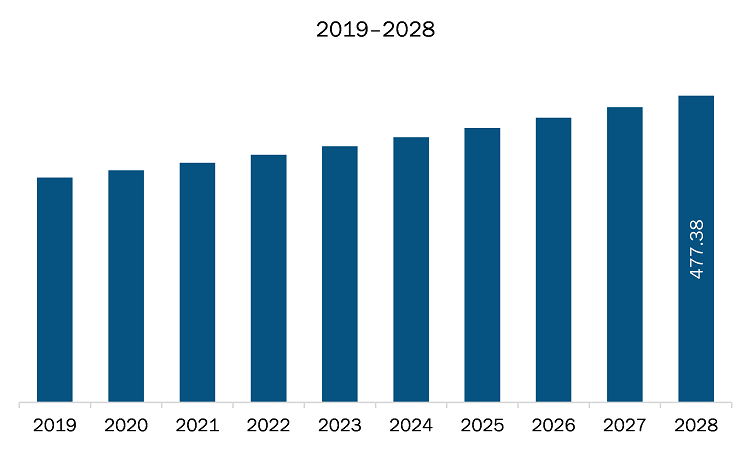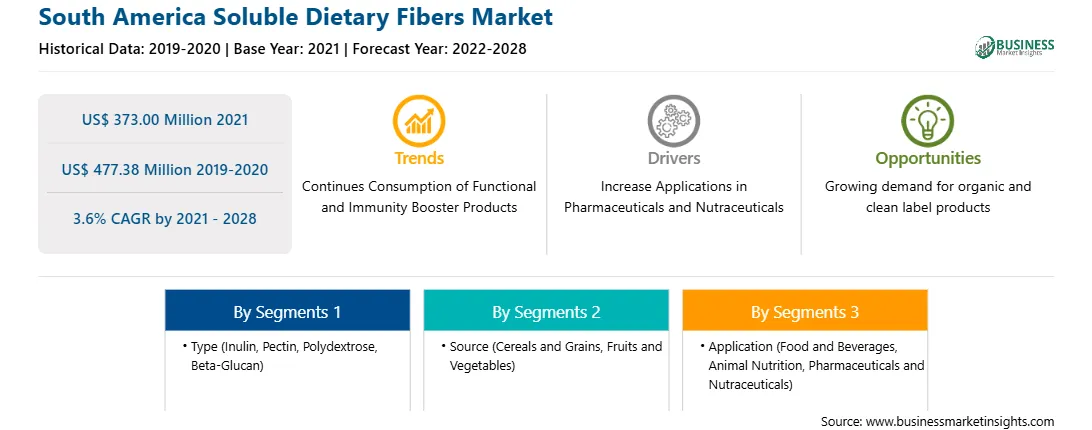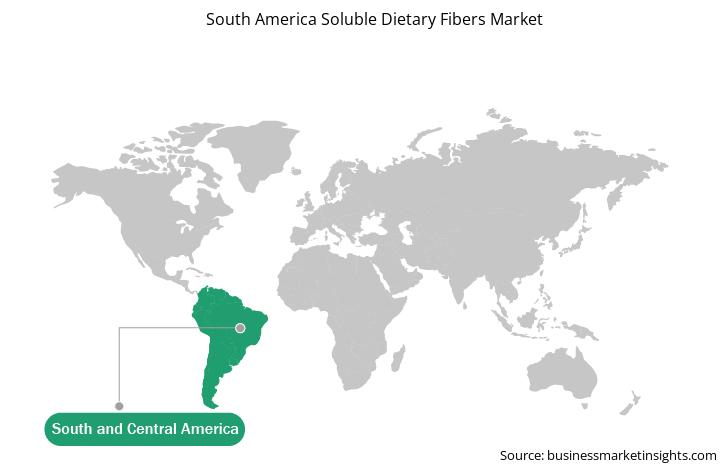The South America region includes countries such as Brazil, Argentina, and the Rest of SAM. The rising health concerns among the consumers is the major driver for the market in South America. The consumers from the region are becoming more aware about benefits of soluble fiber intake. Additionally, the increasing purchasing power of the consumers further contributes to the growth of the market. Many food manufacturers from the region are utilizing soluble fibers from various sources such as fruits and vegetables, cereals and grains, legumes, and nuts and seeds, to develop fortified food products with high-fiber content. These soluble dietary fibers enable food manufacturers to create calorie-reduced products with improved nutritional profiles. Many players operating the region are constantly expanding their product portfolios to meet the dynamic consumer demands. These players are also promoting a more balanced diet for animals. Thus, the growing demand of soluble dietary fibers in animal feeds is expected to boost the growth of the market.
Brazil has been ranked to be the third-most affected economy due to COVID-19 pandemic globally. In South America, Brazil has the highest number of COVID-19 cases, followed by Ecuador, Chile, Peru, and Argentina, among others. The governments in South America have taken an array of actions to protect their citizens and combat the spread of COVID-19 virus through lockdowns, trade bans, and travel restrictions. This may have a direct impact upon the growth of the soluble dietary fibers market.

Strategic insights for the South America Soluble Dietary Fibers provides data-driven analysis of the industry landscape, including current trends, key players, and regional nuances. These insights offer actionable recommendations, enabling readers to differentiate themselves from competitors by identifying untapped segments or developing unique value propositions. Leveraging data analytics, these insights help industry players anticipate the market shifts, whether investors, manufacturers, or other stakeholders. A future-oriented perspective is essential, helping stakeholders anticipate market shifts and position themselves for long-term success in this dynamic region. Ultimately, effective strategic insights empower readers to make informed decisions that drive profitability and achieve their business objectives within the market.

| Report Attribute | Details |
|---|---|
| Market size in 2021 | US$ 373.00 Million |
| Market Size by 2028 | US$ 477.38 Million |
| Global CAGR (2021 - 2028) | 3.6% |
| Historical Data | 2019-2020 |
| Forecast period | 2022-2028 |
| Segments Covered |
By Type
|
| Regions and Countries Covered | South and Central America
|
| Market leaders and key company profiles |
The geographic scope of the South America Soluble Dietary Fibers refers to the specific areas in which a business operates and competes. Understanding local distinctions, such as diverse consumer preferences (e.g., demand for specific plug types or battery backup durations), varying economic conditions, and regulatory environments, is crucial for tailoring strategies to specific markets. Businesses can expand their reach by identifying underserved areas or adapting their offerings to meet local demands. A clear market focus allows for more effective resource allocation, targeted marketing campaigns, and better positioning against local competitors, ultimately driving growth in those targeted areas.

The soluble dietary fibers market in South America is expected to grow from US$ 373.00 million in 2021 to US$ 477.38 million by 2028; it is estimated to grow at a CAGR of 3.6% from 2021 to 2028. The use of soluble dietary fiber is rising fairly in beverages and drinks as it shows better dispersibility in water in comparison to insoluble fiber. Additionally, the incorporation of soluble dietary fiber in beverage formulations helps improve the overall physical and chemical properties as the beverage particles get uniformly distributed; enhance the stability; and prevent precipitation and stratification. Such functional beverages promote satiety, help in weight management, and minimize the need to the intake other high calorific foods. Different types of soluble fibers such as grains and multi-fruits, pectins, β-glucans, and cellulose beet-root fiber, can be used in preparation of beverages. For instance, as per an article published by the National Center for Biotechnology Information (NCBI), oat fiber can be effectively used in preparation of milk shakes, instant type-breakfast drinks, fruit and vegetable juices, iced tea, sports drinks, cappuccino, and wine. An article published by PreScouter” Natural Replacements for Sugar in Beverages” in April 2018, stated that the soluble fiber, inulin, is considered as a perfect ingredient which can be used in instant beverages, soy drinks, and flavored waters, especially “functional” beverages. Inulin possesses high solubility in water along with providing extra strength to body. Inulin is considered as an ideal sugar replacer in low-calorie beverages. Similarly, an article published by FoodIngredientsFirst in April 2020, represented that soluble fibers and natural flavors have grown indispensably in the sweeteners market, attributable to significant shift toward sugar-reduced foods as well as enhanced mouthfeel, texture, and sweetness. The rising inclination toward replacing sugar with artificial sweeteners to improve texture, taste, and nutrition has driven the demand for soluble dietary fibers such as chicory inulin. Chicory inulin possesses a sweetness of approximately 10% in comparison with that of sucrose and has the capability to replace sugars in 1:1 ratio in many applications. Similarly, Litesse Ultra polydextrose is another soluble fiber, which can effectively substitute the lost texture and mouthfeel by reduction of sugar. Similarly, prebiotic dietary fibers, possessing high solubility in water, are significantly used in beverage formulations to promote the digestive health. For instance, barley, which is composed of –20 grams of beta-glucan per 100 grams, is significantly used as a popular cereal grain to produce beer. It contains 2. Beta glucan (β-glucan) is a type of soluble fiber which is known for several functional and bioactive properties and helps to minimizes the risk of dyslipidemia, hypertension, and obesity. Companies such as Ingredion is involved in offering NUTRAFLORA soluble prebiotic fiber, which enhances the flavor of beverages along with acting as an effective sugar substitute. Similarly, Fibersol—a joint venture between Archer Daniels Midland Company; Matsutani Chemical Industry Co., Ltd.; and Matsutani America—is involved in providing low-viscosity soluble prebiotic dietary fiber, which helps increase the fiber content and enhance the nutritional profile of different types of beverages such as juices & fortified waters, shakes & smoothies, protein & nutritional, yogurt & dairy-based, coffee & tea, sports & energy, and carbonated & alcoholic. Hence, the soluble dietary fiber acts as an effective sugar replacement and can also be used as a prebiotic fiber in beverage formulations.
In terms of type, the inulin segment accounted for the largest share of the South America soluble dietary fibers market in 2020. In terms of source, the cereals and grains segment accounted for the largest share. Further In term of application, the food and beverages held a larger market share of the soluble dietary fibers market in 2020.
A few major primary and secondary sources referred to for preparing this report on the soluble dietary fibers market in South America are company websites, annual reports, financial reports, national government documents, and statistical database, among others. Major companies listed in the report are Cargill, Incorporated, Kerry Group, Ingredion Incorporated, Nexira, Roquette Frères, Tate & Lyle PLC, ADM, IFF Nutrition & Biosciences, and BENEO GmbH among others.
The South America Soluble Dietary Fibers Market is valued at US$ 373.00 Million in 2021, it is projected to reach US$ 477.38 Million by 2028.
As per our report South America Soluble Dietary Fibers Market, the market size is valued at US$ 373.00 Million in 2021, projecting it to reach US$ 477.38 Million by 2028. This translates to a CAGR of approximately 3.6% during the forecast period.
The South America Soluble Dietary Fibers Market report typically cover these key segments-
The historic period, base year, and forecast period can vary slightly depending on the specific market research report. However, for the South America Soluble Dietary Fibers Market report:
The South America Soluble Dietary Fibers Market is populated by several key players, each contributing to its growth and innovation. Some of the major players include:
The South America Soluble Dietary Fibers Market report is valuable for diverse stakeholders, including:
Essentially, anyone involved in or considering involvement in the South America Soluble Dietary Fibers Market value chain can benefit from the information contained in a comprehensive market report.